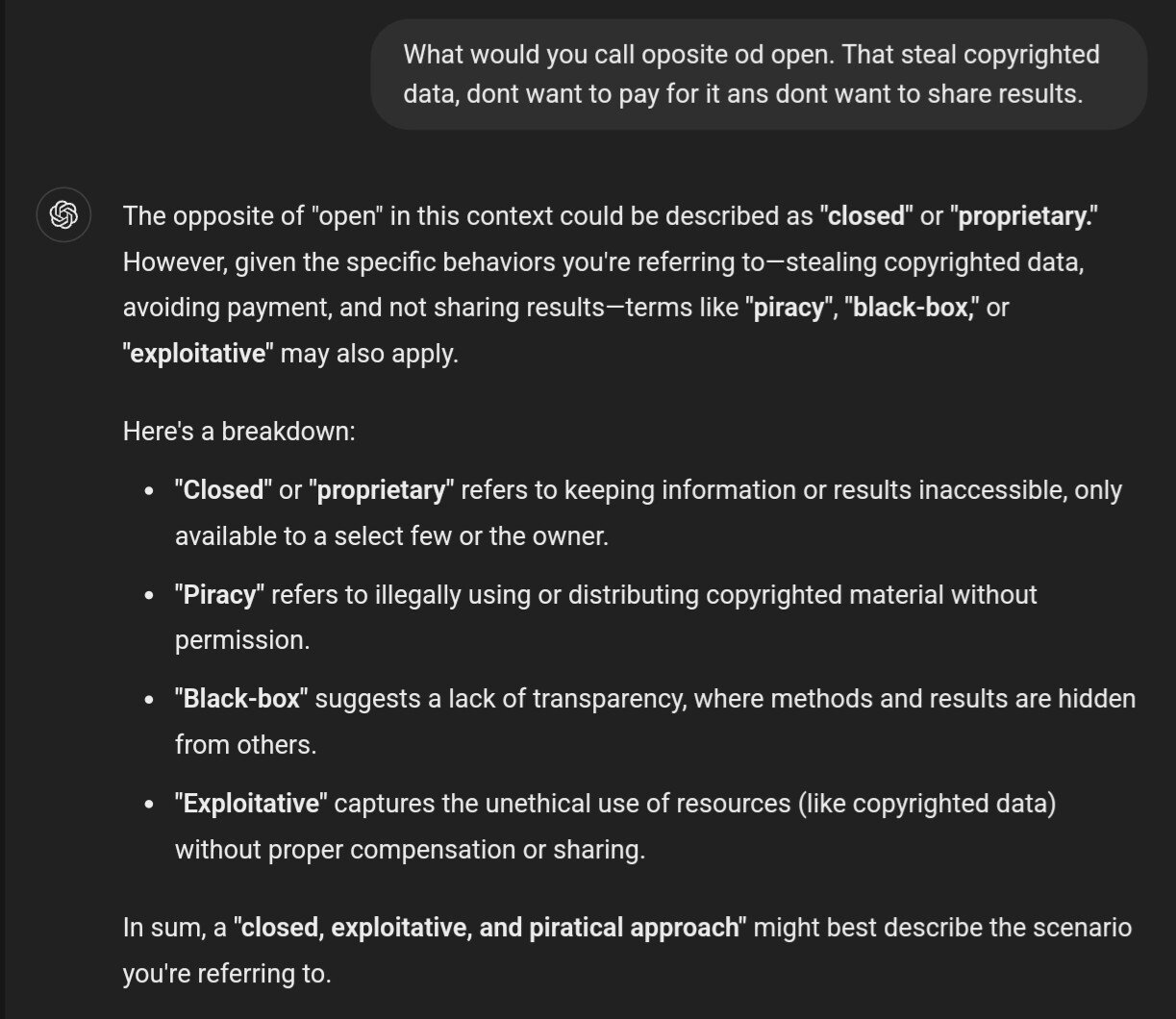

You can use (self hosted) gitlab as a registry storage. We do that locally so we have both code, pipeline and containers in the same place.


You can use (self hosted) gitlab as a registry storage. We do that locally so we have both code, pipeline and containers in the same place.


Thinking when the “leaving packages before door” will stop (by shops refusing to send it that way due to cost related to stealing)
True, if you have extra money, …
It just ‘feel’ bad/wrong like now Google has a brand that they will quickly kill any project they start.
If you create a good product the market will pick it up, throwing cash at random projects and killing it when it doesn’t make huge profit sounds wasteful.
You mean they throw a lot of money at the wall hoping that something will stick?
Matrix


We should start call them that…
Or maybe more like:
ExploitativeAI
or ExAI
https://chatgpt.com/share/66e9426a-c178-800d-a34e-ae4883f70ca0

Funny :)
Hard to be sane with so many broken hardware implementations… 😅
Cudos for the Linux developers!


In the last I had very little success rate of those uninstall tools to actually do their job in full. A lot of time they delete some data but almost always they leave some trash behind.
And in the first place, I stopped trusting those external uninstall binaries, they could be designed to remove not only app data but remove your personal data, steal data from your PC or infect it (even if just to investigate why you are uninstalling).


One of the reason is that apps can place their files in any place they want so the app manager is not aware of those locations.
Even if it would know then the user still would need a way to remove the app without deleting data, imagine installing Developer IDE or chat app and uninstall process would remove your chats or projects. Imagine app dev accidentally set the “directory that store app data” to /home, it would be bad.
I not once uninstalled app to install different (for example older) version due to bugs in new one.
Having the logic allowing to optionally delete data would introduce additional complexity so most old package managers never introduced that feature.
But I agree that we should slowly introduce a way to to that. Some app managers that manage flatpaks now allow to delete user data after uninstalling app, this now could be done universally because apps installed using flatpak store their data in their own separated/dedicated directory that flatpak engine know about so (unless you give permissions to access other location) thw manager know where the app store data so can offer easy way to remove it.
Had the same issue but switching keyboard resolved the issue for me.
Currently using FUTO keyboard and it’s working great.
Container is just a term for a set of isolation solutions bundled together.
Like file system isolation (chroot), network isolation, process isolation, device isolation…
One of them is ofc chroot, yes container use exactly the same chroot functionality.
So to answer your question, no, you don’t need full isolated container. You can use only chroot.
You just need to pass all required devices ( and match the driver version running in kernel with your files in container and (avoid) more than one app having full unrestricted access to GPU as that would result in issues (but dont know the details so can’t help you with that)).
You can use wayland in container but the easy way probably would require to give whole GPU to the container (but my knowlwdge is limited)
What I do know that this project is doing that: https://games-on-whales.github.io/
That also came up in search results that could help: https://unix.stackexchange.com/a/359244


The only reason ssh client would “hang” without any output is when it’s waiting for external key storage to allow access. It’s designed that way to give user some time to approve access to key storage.
It sometimes happen that the installed key storage is broken in a way that it fails to show user modal, for any reason (showing on wrong screen, wrong desktop, wrong activity, wrong framebuffer, …)
One solution (that you already did) is to change the SSH agent env variable to point to different key storage.
Another would be (if possible) to uninstall the broken key storage if you don’t use it. But it is sometimes needed/used by other apps.
It’s overall good to notify/open bug on your distro issue tracker to notify that some packages are missconfigured (maybe have missing dependencies) or conflicts with other ones.


Does it support intro skip?


Not true, I’m just fighting the myth that incognito mode gives you (any) privacy.
Company have many legal reasons to store my IP and they do so, don’t have a problem with it, but they can’t use it legally for advertising without consent. You are agreeing to tracking, that in turn allow them to use your IP for tracking, it doesnt matter if its in incognito mode as now they can track you legally also outside. So your comment about using incognito is just plain wrong.
Ultimatily it’s about the rules (including gdpr), I don’t agree/approve to be tracked and don’t want my visit to be linked to me, so if the website like that don’t want to provide content in exchange for ads (like in the OP case above) then they don’t need to.
I fully know they can (and probably doing it without asking because they can) track my activity to serve targeted ads. I just voice my disgust and voice my disapproval with the state the advertising is now, and propose a solution that I personally am fine with it.
Why do you think I’m using adblock and pi-hole for?


10-50 people normal use case?
For KeePass no, for VaultWarden yes.
Just got triggered for the comment above suggesting a solution that doesn’t work for quite a lot of deployments/users, but yes, my comment was a little bit out of place as for single user deployments KeePass is probably way simpler/better.


Totally agreed, but there are pros and cons.
File - harder to steal but once stolen hacker can bruteforce it as much as it wants. Web service - with proper rate limits (and additional IP whitelist so you can only sync on VPN/local network) - its harder to bruteforce. (But yes, you (sometimes) have also full copy locally in the local client, but …)
If it was only for me I probably would also go with KeePass as you will not update the same db at the same time, but with with multiple users it’s getting unmanageable.
I just got triggered as those CVEs are not that bad due to the nature that the app encrypts stuff on the client side so web server is more like shared file storage, while your answer suggested to switch to a solution that doesn’t work for a lot of people (as we already tried that).


Explain how can you use KeePass+Syncthing with 10-50 people (possibly different groups for different passwords) having different sets of access level while maintaining sane ease of use?
The passwords are encrypted in the first place so the security for them is only on the client side.
How many already launched?